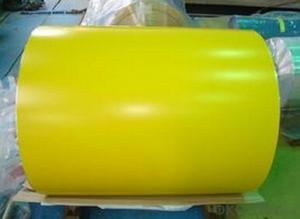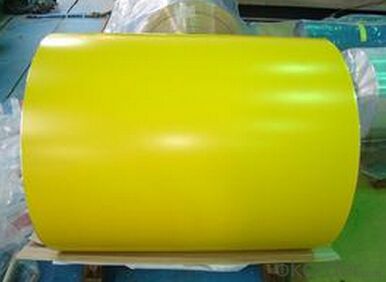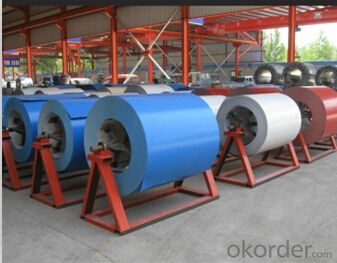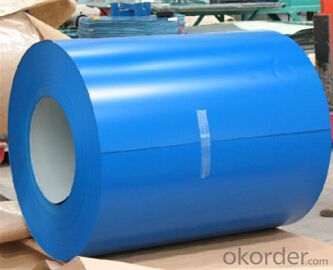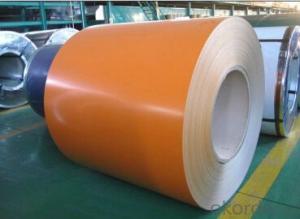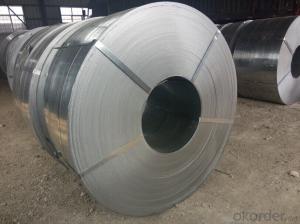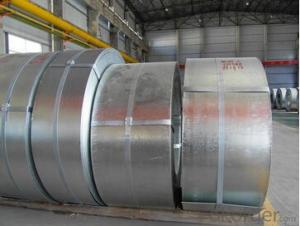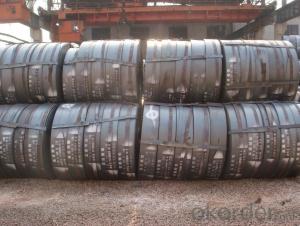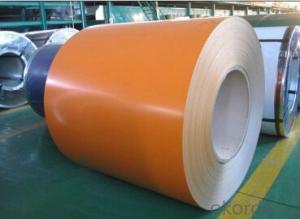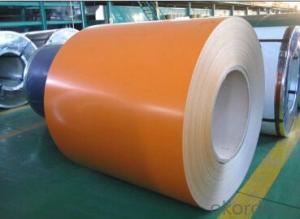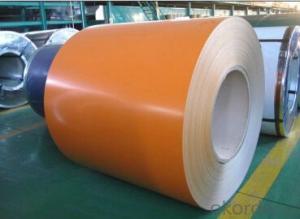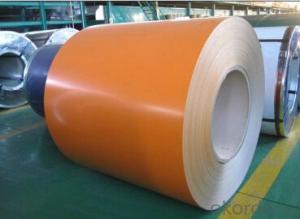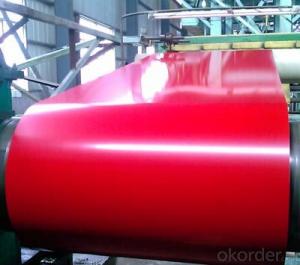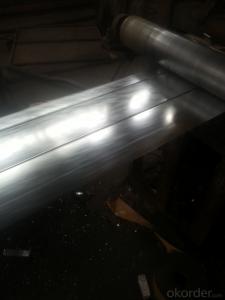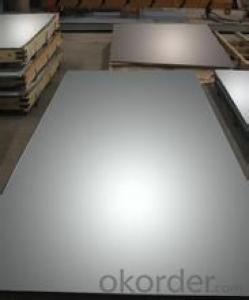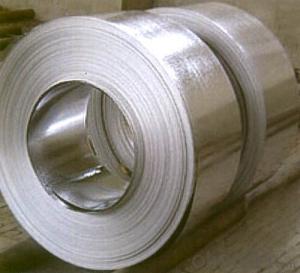Best Prepainted Galvanized steel Coil ASTM 615-009
- Loading Port:
- Tianjin
- Payment Terms:
- TT OR LC
- Min Order Qty:
- 111 kg/m²
- Supply Capability:
- 11 kg/m²/month
OKorder Service Pledge
OKorder Financial Service
You Might Also Like
1.Structure of Prepainted Galvanized steel Coil :
With Gi as base metal,after pretreatmet (degrease and chemical treatment) and liquid dope with several Layers of color,then after firing and cooling,finally the plate steel is called pre-painted galvanized steel ( PPGI) .Pre-painted galvanized steel is good capable of decoration ,molding,corrosion resistance lowering the cost of production and increasing the quality of the metal. Today, steel is one of the most common materials in the world, with more than 1.3 billion tons produced annually. It is a major component in buildings, infrastructure, tools, ships, automobiles, machines, appliances, and weapons. Modern steel is generally identified by various grades defined by assorted standards organizations.
2.Main Features of Prepainted Galvanized steel Coil:
• Excellent process capability
• Smooth and flat surface
• Workability, durability
• Excellent heat resistance performance
• High strength
• Good formability
• Good visual effect
3.Prepainted Galvanized steel Coil Images
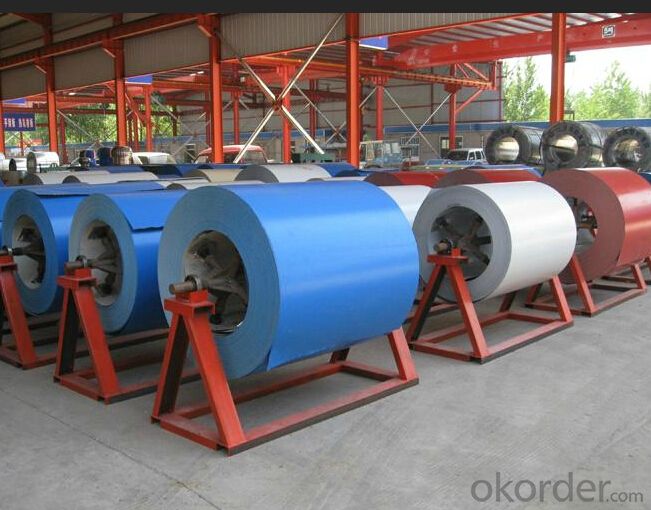
4.Prepainted Galvanized steel Coil Specification
Standard:ASTM, GB,JIS,JIS G3302 ASTM 755 EN10169
Grade: DX51D CGCC CS
Thickness: 0.13mm~3.0mm,
Width: 1250,600-1250mm
Coil weight:3-12 MT
Coil ID:508/610mm
Chemical composition:
C | Si | Mn | Cr | Ni | P | S |
0.150 | 0.476 | 11.231 | 12.50 | 0.900 | 0.039 | 0.010
|
5.FAQ of Prepainted Galvanized steel Coi
We have organized several common questions for our clients,may help you sincerely:
1.How do you control your quality
We have established the international advanced quality management system,every link from raw material to final product we have strict quality test;We resolutely put an end to unqualified products flowing into the market. At the same time, we will provide necessary follow-up service assurance.
2.how long we will receive the goods ?
After receiving your deposit or workable lc ,our normal shipment date is 15-20days,and it takes around 28 days to reach your port of destination. But is up to different destination
3. what is your moq
Normally our moq is 25per size ,but it is up to different size
- Q: How are steel strips processed for surface coating removal?
- There are various methods available for removing surface coatings from steel strips. One commonly used approach is mechanical stripping, which entails using abrasive materials or equipment to physically eliminate the coating. Sandblasting, for instance, involves propelling abrasive particles onto the steel surface using high-pressure air or water, effectively stripping away the coating. Chemical stripping is another technique employed to remove surface coatings. This involves applying chemicals or solvents to the steel strips to dissolve or soften the coating, making it easier to remove. The strips are then rinsed or washed to eliminate any remaining residue. Thermal stripping is also a popular method, which entails heating the steel strips to high temperatures. This causes the coating to burn off or decompose, allowing for easy removal. This technique is particularly effective for organic coatings. In addition to these methods, some companies utilize advanced techniques like laser or plasma coating removal. These methods employ intense heat or energy to vaporize or ablate the coating from the steel surface. Once the surface coating has been removed, the steel strips may undergo further processing such as cleaning, rinsing, or passivation to prepare them for subsequent treatments or applications.
- Q: What are the safety considerations when working with steel strips?
- When working with steel strips, some safety considerations include wearing appropriate personal protective equipment such as gloves, safety glasses, and steel-toed boots to protect against potential cuts, punctures, and falling objects. It is also important to ensure that the work area is clear of any debris or tripping hazards, and that the steel strips are handled and stored properly to prevent any injuries. Additionally, workers should be trained on safe lifting techniques and aware of the potential risks associated with working with heavy materials.
- Q: How are steel strips rolled to achieve desired thickness?
- Steel strips are rolled to achieve the desired thickness through a process known as cold rolling. This process involves passing the steel strip through a series of rolling stands, which gradually reduce its thickness. Initially, the steel strip is fed into the first rolling stand, where it is compressed between two rotating cylinders. As the strip passes through the gap between these cylinders, it is subjected to high pressure, causing it to deform and reduce in thickness. After passing through the first stand, the strip is directed to the next set of rolls, typically referred to as the intermediate rolls. These rolls are positioned at a slightly smaller gap than the previous set, further reducing the thickness of the strip. This process continues, with the steel strip passing through several additional stands, each with progressively smaller gaps, until the desired thickness is achieved. The number of stands required depends on the initial thickness of the strip and the final desired thickness. In addition to reducing the thickness, cold rolling also improves the surface finish and mechanical properties of the steel strip. It helps to align the grain structure of the material, making it stronger and more uniform. Overall, the rolling process allows for precise control over the thickness of the steel strip, enabling manufacturers to produce strips of varying thicknesses to meet specific requirements for different applications.
- Q: How are steel strips welded together to form larger structures?
- Steel strips are welded together to form larger structures using various welding techniques such as arc welding, MIG welding, or TIG welding. These techniques involve melting the edges of the steel strips and fusing them together using heat and pressure. The welds create a strong and durable bond, allowing the steel strips to be assembled into larger structures such as beams, frames, or even entire buildings.
- Q: What are the properties of steel strips?
- Steel strips typically possess several properties that make them highly versatile and widely used in various industries. Some key properties of steel strips include high strength, excellent durability, good corrosion resistance, and high heat resistance. They can also be easily shaped, formed, and welded, making them suitable for a range of applications such as automotive components, construction materials, and electrical appliances. Additionally, steel strips have a high weight-to-strength ratio, making them an ideal choice for lightweight structures.
- Q: How do steel strips perform in high-speed applications?
- Steel strips perform well in high-speed applications due to their high strength, durability, and ability to withstand extreme temperatures and pressures. Their excellent mechanical properties and resistance to fatigue make them suitable for use in various industries, such as automotive, aerospace, and manufacturing, where high-speed operations are common.
- Q: Are steel strips suitable for the manufacturing of oil and gas pipelines?
- Yes, steel strips are suitable for the manufacturing of oil and gas pipelines. Steel has excellent mechanical properties and is known for its high strength, durability, and resistance to corrosion, making it an ideal material for pipelines that need to withstand high pressure and harsh environments. Additionally, steel strips can be easily formed and welded together, allowing for efficient manufacturing and installation of pipelines.
- Q: How do steel strips perform in flexible assemblies?
- Steel strips perform well in flexible assemblies as they are strong, durable, and resistant to bending and deformation. They provide stability and reinforcement to the assembly, ensuring that it maintains its shape and structure even when subjected to various forces and movements. Additionally, steel strips offer excellent corrosion resistance, making them suitable for a wide range of applications in flexible assemblies.
- Q: What does "strip 50" mean?
- Medium carbon high strength carbon steel, after quenching with high strength and hardness of the steel cutting medium, cold plastic deformation, poor welding, heat treatment when no temper brittleness, but the hardenability is low, the critical diameter of water is 13*30mm, and when the water quenching cracking tendency. This steel is usually used after normalizing or quenching, tempering, or high frequency surface hardening.
- Q: How are steel strips processed for surface deburring?
- Steel strips are processed for surface deburring using various techniques, depending on the specific requirements and the type of equipment available. One common method is mechanical deburring, which involves the use of abrasive tools or machinery to remove burrs or rough edges from the surface of the steel strips. This can be done manually by hand-held tools or with automated machinery that can process large volumes of steel strips. Another method is chemical deburring, which involves the use of chemicals or acid baths to dissolve or break down the burrs on the surface of the steel strips. This process is often used for complex or intricate parts where mechanical deburring may not be effective. Other techniques such as thermal deburring or electrochemical deburring may also be employed, depending on the specific requirements of the steel strips. Thermal deburring involves using heat to remove burrs, while electrochemical deburring uses an electric current to dissolve the burrs. Regardless of the method used, it is important to ensure that the steel strips are properly cleaned and prepared before the deburring process. This may involve washing the strips to remove any contaminants or oils that may be present on the surface. Overall, the process of surface deburring for steel strips involves choosing the appropriate method based on the specific requirements, using the necessary tools or machinery, and ensuring proper cleaning and preparation of the strips before deburring.
Send your message to us
Best Prepainted Galvanized steel Coil ASTM 615-009
- Loading Port:
- Tianjin
- Payment Terms:
- TT OR LC
- Min Order Qty:
- 111 kg/m²
- Supply Capability:
- 11 kg/m²/month
OKorder Service Pledge
OKorder Financial Service
Similar products
Hot products
Hot Searches
Related keywords
